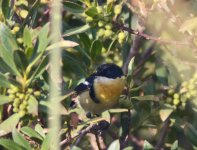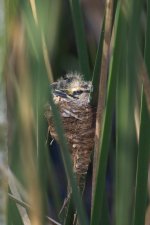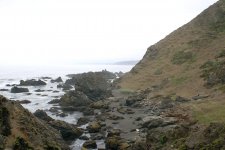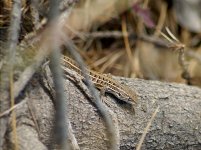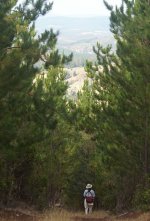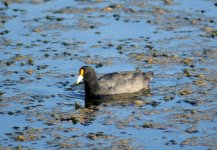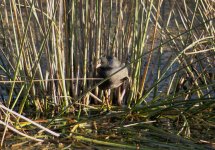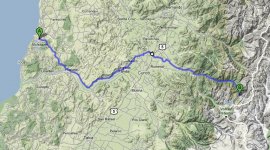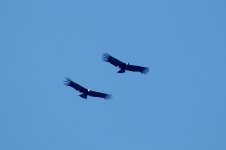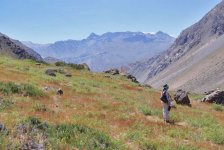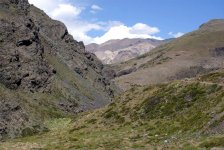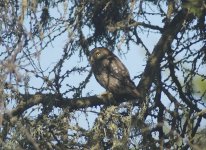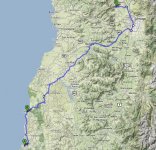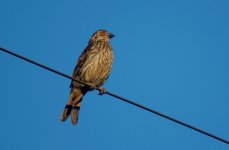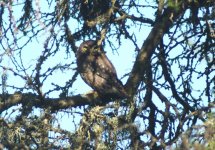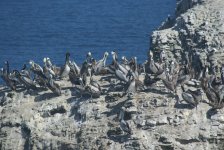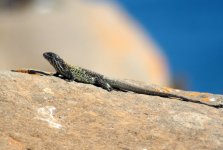Day 08: Sunday, Jan 02. Hacienda Laguna Torca - Santiago
The dreaded day had finally arrived - departure. (
¡Que Lastima!) However, thanks to our the convenience of having an overnight flight back to Toronto (departing at 1945), we weren't really in a terrible hurry today; even leaving a generous amount of time (I estimated 5.5 hrs) for the drive back to the Santiago airport, we still had a few hours for birding along the way...
First, though, had to make a farewell visit to the Reserva before breakfast. For one thing, I was really hoping to get another crack at photographing Mr. "Pied Bagelface". So, replacing scope with camera atop the tripod, I started to march down the HLT entrance lane one more time. This lane runs through their olive grove, and I had just entered this stretch when I saw what I could only describe as a "problem bird". It was thrush-shaped, and it perched briefly on top of one of the small olive trees, calling once before dashing off again. It was both like and unlike a standard
zorzal - it seemed to be the right size, but much too dark, especially on the breast, and the flight didn't seem quite right to me either ... hmmm...
Unfortunately, being burdened with a lot of photographic hardware, and lacking the assistance of my "spotter" (who still back at the Cascada lodge, fussing over the packing or something - I'm more of a "toss everything in the bag five minutes prior to departure" sort of person), I lost sight of this bird before being able to get any kind of reasonable look at it. Intriguing, though.
After staking out the Spectacled Tyrant for a while (without success), DMM joined me, and we paid a brief visit to the Rush-tyrants along the boardwalk. They were still at their popping-corn best, and it seemed like every adult we saw had a hungry young one chasing it around. We went along as far as the nest we'd seen the other day, and noticed that the young in it had fledged - or, at least, the nest was empty, we hoped they had fledged! (They did seem awfully young when we first saw them, just 2 1/2 days ago; on the other hand, it's true that small passerines can grow up very fast.) On our way back, DMM got a good look at a Plumbeous Rail from the boardwalk - I just managed to catch the brightly-coloured feet as it stalked away into the rushes.
After another wonderful breakfast at the main house, we very regretfully took our leave of Hacienda Laguna Torca. But the Hacienda - or, at least, its birds - were not quite done with us; before we were even halfway down the lane, I spotted my "not-thrush" again. It was perched in plain sight, and didn't seem in a hurry to go anywhere. This time, I had the scope handy (I'd made sure not to pack
that just yet), so we got a much better view. We could now see that this was not a thrush at all, but actually a shrike-tyrant, one of a group of very big new world flycatchers - a very exciting find, indeed! Out of that genus, we were able, based on the all-dark tail, the heavily streaked throat, and very heavy bill, to narrow it down to the largest of the bunch, the Great Shrike-tyrant. (Oh, and the range was a bit of a factor too). This species is extraordinarily large for a flycatcher, slightly exceeding American Robin or (Eurasian) Blackbird in length and bulk; large enough, according to
Birds of Chile, "to eat small birds" on occasion.
So - what a fine send-off from HLT that was! (I love these last-minute finds.) Or, it
would have been our send-off, except that - after we had congratulated ourselves, packed scope, bins, and selves back into the car, and driven about 100 m. further down the lane - I saw a small, brown, blur: it crossed the lane in front of us, flew into the neighbour's pasture, and disappeared into a large thorn bush. That, in itself, was not so interesting; but the cacophony of angry bird-calls, which erupted from this bush immediately afterwards - this, most definitely,
was.
[aside] I doubt that anyone who is reading this needs to be told this, but paying attention to bird sounds - even sounds which I don't recognize - is always incredibly important in the birding game. I would seldom see anything at all if I didn't hear it first, and I am still surprised at how surprised "muggles" are at this; they think they can natter away constantly on outings, and still expect to see birds...
In this case, without the auditory component, that "brown blur" could have been virtually any small bird; but, with the sound of a whole bunch of other birds going ballistic added, we instantly knew we had a predator of some kind on our hands... [/aside].
Anyway, we hastily unpacked scope, bins, and selves again, and directed all of the above at the aforementioned bush. A Chilean Mockingbird was on the near side of it, jabbering constantly, while a Thorn-tailed Rayadito fluttered around on top, obviously in a state of considerable agitation. Also, somewhere in there, I could hear at least one Southern House Wren adding to the chorus of ire. And, there at the focus of it all, was a small round head, out of which stared a pair of baleful yellow eyes. What a lucky break, our second Austral Pygmy-owl in as many days! (And to give my her credit,
la señora was very glad - relieved might be a better word - that I wouldn't be having to go home without one...).
One small problem was that the owl was out of camera range - and the six-foot-tall barbed-wire fence surrounding the pasture seemed to lack a gate anywhere. But it was too good an opportunity to pass up, so I (verrrrry carefully) climbed over and stalked up to it - never got really close, but good enough for a few shots. (Hence, the picture from last week's instalment - it just seemed like a better place for it.) Looking at these two birds cost us a bit of time, but it was still only about 0900 when we tore ourselves away; this left us, in my estimation, a good 3-4 hours "flex-time" for sight-seeing on the way to the airport.
There were, roughly speaking, two routes available to get us up to Santiago. One, the fastest, would be to go through the wine country around Santa Cruz, and get back on the big north-south highway at San Fernando. The second, more time-consuming, route would be to stick with the coast until Pichilemu, and then take an angled route across country, approaching the capital from the south-east. We choose the latter option, partly because we thought it would be a more relaxed drive than the "Ruta 5" (and, incidentally, skip some toll booths), but also because we would be able to check out Lago Rapel along the way. This is a large artificial lake about halfway between Pichilemu and the southern outskirts of Santiago, and our road would take us right over the dam at the north end of it.
Our first priority, however, was to visit Punta Lobos again, for seabirds - this time, with scope! It was bright and sunny when we arrived, with an bit of an onshore breeze - good conditions for actually being able to see the pelagics this time, I thought. With better magnification, those few "little black crosses" we'd previously seen multiplied into hundreds - just clouds of them swirling about over the ocean's surface as far as the scope could reach. Even the closest of them were not really that close, but we could ID some of them as Sooty Shearwaters (who knows, they may have all been Sootys - they are supposed to be the most abundant shearwater in the area). It was interesting to watch their movements - they were by no means evenly distributed out there, but seemed to "clump" a lot. After a while, it seemed to us that we could detect a pattern to this behaviour - a "clump" of shearwaters would be gathered around an individual Peruvian Pelican, presumably using it as a "beater".
Once, however, we witnessed something rather different - the tubenoses were scattering, rather than gathering. Something large, and very fast, was flying amongst them, and the this "something" had big white patches in its wings - definitely a skua of some kind or other. I cannot say much more than that (it was very far out), except that it was a big bird - comparable to a Kelp Gull, one of which we saw it pursuing for a while.
We also saw a large, dark tubenose, not a shearwater, pass by again. This time, we were able to see the bill well enough to be able to say that yes, that's really massive - so it just had to be a giant-petrel. No way, though, that we could tell which giant-petrel without a much better view - we sat for quite a while, hoping it would return, but it never did. While waiting, DMM noticed a mammal in the waves below; not a surfer, for a change - there was a sea lion poking his head above the surface every once in a while. These can be distinguished from all the other local pinnipeds by their sharply turned-up noses - how about that? Learn a new thing every day.
After Punta Lobos, we visited Pichilemu again, to gas up the car. It was absolute mayhem in there, it seemed like half of Santiago had decided to come down for the weekend. I was worried, a bit, that we'd have some very heavy traffic to face on the way back to the city. Thankfully, this did not turn out to be the case, and once were on highway K-150 (to Las Damas and Litueche) all was relatively quiet again. Nothing of birdy significance, then, until we stopped at the Rapel reservoir. This was a bit of a bust, in that we only saw one species of waterbird there (Great Grebe), but that may have had much to do with the time of year; I can well imagine that, had we been visiting in fall or winter, we might have found it to be full of migrants from Patagonia and the high Andes.
After Lago Rapel, a bit of ho-hum driving across farming country took us to the small city of Melipilla. From there, we were back on to the fast toll-road system, which got us back to Santiago in a flash. Since we had made pretty good time, we still had a couple of hours to play with; so, we decided we could afford to continue right through the city, and visit the Lampa marshes, a bit to the north.
This marshy stretch, right along a road, is relatively well-known, largely because of the presence of South American Painted-snipe. Apparently, this is one of the best places in the world to find this species, or so I had read (although always with the qualifier "when the water level is right"). Well, I don't know if the water levels were right or not, but we certainly couldn't find any! Plenty of birds around, mostly Cattle Egrets, stilts, and lapwings, but nothing remotely snipe-like. To be fair though, we didn't have a lot of time to devote to this place, and mid-afternoon is hardly the best time of day. Nonetheless, I can really see why people would recommend alternatives to this place (like nearby Batuco); there's quite a bit of traffic going by, and also quite a bit of trash blowing around. There
is a bit of a viewing platform, from which we saw some ducks (including Red Shoveler) and coots, but nowhere nearby to park! So, not a very good experience, from out point of view - I suppose the experience of Laguna Torca had rather spoiled us.
Anyway, the clock was pushing 1700, and I thought we might need about 45 minutes to get to the international airport - so, time to put the scope away, and get a move on. Managed to not get lost on the way, and returned the (very dusty)
El Pequeño to the Econorent office at the airport just after 1800hrs. (They were wonderful about this; although we were, strictly speaking, more than four hours late, they charged us for only the regular one-week rate, plus one hour overtime. Better still, they chose to overlook the small, ahem, incident involving the gate post I grazed back at Lago Vichuquen.)
Not being ones to ever let any time go to waste, after our checking the baggage, we thought we'd did a quick walk around the airport grounds. Didn't turn up any new birds at all, but - after seven days and a bit - I finally, finally, managed to get a decent picture of a
zorzal.
92. Great Shrike-tyrant
93. Sooty Shearwater
94. Black-crowned Night-heron
95. Red Shoveler
Photos: Route from Laguna Torca to Lampa; a female plantcutter at HLT; a slightly different angle on the Pygmy-owl; pelicans at Punta Lobos; neat lizard (species unknown) at Punta Lobos.





